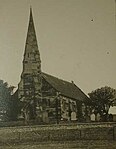Shenstone railway station
Former London and North Western Railway stationsLichfield DistrictRailway stations in Great Britain opened in 1884Railway stations in StaffordshireRailway stations served by West Midlands Trains ... and 3 more
Staffordshire building and structure stubsUse British English from February 2017West Midlands (region) railway station stubs

Shenstone railway station is a railway station on Station Road, in the village of Shenstone, in Staffordshire, England. It is situated on the Cross-City Line between Redditch and Lichfield via Birmingham.
Excerpt from the Wikipedia article Shenstone railway station (License: CC BY-SA 3.0, Authors, Images).Shenstone railway station
Admiral Parker Drive, Lichfield Shenstone
Geographical coordinates (GPS) Address Nearby Places Show on map
Geographical coordinates (GPS)
| Latitude | Longitude |
|---|---|
| N 52.639 ° | E -1.844 ° |
Address
Admiral Parker Drive 1
WS14 0NW Lichfield, Shenstone
England, United Kingdom
Open on Google Maps









